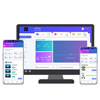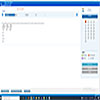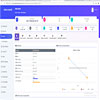
Our Products
Our wide Range of Products, designed to help your institute/Organization/Business grow exponentially
Home / OMR Sheets
OMR (Optical Mark Recognition) sheets are special types of paper forms that are used for collecting data electronically through the use of scanning and software technology. OMR sheets contain pre-printed bubbles, boxes, or lines that correspond to specific responses. The user fills in the appropriate bubble or box with a pencil or pen, and the OMR scanner reads the marked response using optical sensors.
Identification fields: areas for providing unique identifiers such as participant name, ID number, or date.
Question or prompt: a statement or question to which the user provides a response.
Response options: pre-defined response options, usually in the form of bubbles, checkboxes, or lines, that correspond to specific answers.
Timing or scoring fields: areas for collecting timing or scoring data, such as response time or number of correct answers.
Registration marks: specific marks on the sheet that help the scanner to accurately read and identify the sheet

Survey OMR sheets:These are used for collecting feedback or survey responses from a large group of people. They typically contain multiple-choice questions and checkboxes for easy response collection.
Examination OMR sheets: These are used for conducting tests or exams that require objective responses, such as multiple-choice questions, true/false questions, or fill-in-the-blank questions. They are usually designed with spaces for participant identification and test scores.
Ballot OMR sheets:These are used for collecting votes in an election or poll. They typically contain candidate names and checkboxes for marking votes. pre-defined response options, usually in the form of bubbles, checkboxes, or lines, that correspond to specific answers.
Attendance OMR sheets:These are used for recording attendance of participants in an event or class. They contain spaces for participant identification and checkboxes for marking attendance. areas for collecting timing or scoring data, such as response time or number of correct answers.
Inventory OMR sheets:These are used for inventory management or tracking. They contain pre-defined fields for collecting information such as item name, quantity, and location.

These are used for collecting data to evaluate the effectiveness of programs, services, or products. They contain pre-defined fields for collecting information such as customer satisfaction ratings, product quality ratings, or program evaluation metrics. The type of OMR sheet used depends on the specific data collection needs of the user.
OMR sheets work by using optical sensors to detect and interpret marks made on the sheet. Here's how the process works:
The user fills in the appropriate response bubbles or checkboxes on the OMR sheet using a pencil or pen.
The OMR sheet is then scanned using an OMR scanner, which uses optical sensors to read and interpret the marks made on the sheet
The scanner then converts the marked responses into electronic data, which can be processed and analyzed using software.
The data collected from the OMR sheet can be used to perform various types of analysis, such as statistical analysis or data visualization, depending on the specific needs of the user.
Factors that can affect the accuracy of OMR sheets include the quality of the OMR scanner, the design and layout of the OMR sheet, the type of marking tool used, and the presence of any extraneous marks on the sheet. To ensure the highest level of accuracy, it's important to use high-quality OMR scanners and carefully design OMR sheets that are easy to use and interpret. The user fills in the appropriate response bubbles or checkboxes on the OMR sheet using a pencil or pen.

Designing an effective OMR sheet requires careful planning and attention to determine. Below are few suggestions for creating OMR sheets:
Use clear and concise instructions
The instructions on the OMR sheet should be easy to read and understand. Use simple language and do not use technical terms or jargon.
Use appropriate response options
The response options should be appropriate for the type of data being collected.
For example, if collecting numerical data, use numeric bubbles or checkboxes instead of letters or words.
Avoid ambiguity
The OMR sheet should be designed in a way that reduces the possibility
of ambiguous responses. For example, avoid using response options that could be interpreted in multiple ways.
Use proper spacing and alignment
Proper spacing and alignment are important for ensuring that the scanner can accurately read the OMR sheet
. Use consistent spacing between response options and ensure that bubbles and checkboxes are properly aligned.
Use registration marks
Registration marks are specific marks on the OMR sheet that help the
scanner to accurately read and identify the sheet. Make sure to include registration marks on the OMR sheet.
Test the design
Before printing a large number of OMR sheets, test the design by scanning a sample sheet to ensure that the scanner can accurately read the responses.
There are also software tools available for designing OMR sheets, which can help to simplify the design process and ensure accuracy. These tools often come with pre-built templates and design elements, making it easy to create custom OMR sheets.
OMR sheets are widely used in various Indian exams, especially those that require objective-type responses. Some of the exams that commonly use OMR sheets in India include

UPSC Civil Services Exam
The Union Public Service Commission (UPSC) Civil Services Exam is a highly competitive exam that is conducted to select candidates for various civil services positions in the Indian government. OMR sheets are used to collect responses from candidates in the preliminary round of the exam.

SSC CHSL Exam
The Staff Selection Commission (SSC) conducts the Combined Higher Secondary Level (CHSL) Exam to hire individuals for multiple government positions.OMR sheets are used to collect responses from candidates in the written examination.

IBPS PO Exam
The Institute of Banking Personnel Selection (IBPS) PO Exam is conducted for the recruitment of probationary officers in various public sector banks. OMR sheets are used to collect responses from candidates in the preliminary and
main examination.

NEET Exam
The Online Exam Website The National Eligibility cum Entrance Test (NEET) is conducted for admission to medical and dental courses in various colleges in India. OMR sheets are used to collect responses
from candidates in the entrance examination.

JEE Main Exam
The Joint Entrance Examination (JEE) Main Exam is conducted for admission to various engineering colleges in India. OMR sheets are used
to collect responses from candidates in the entrance examination.

CTET Exam
The Central Teacher Eligibility Test (CTET) is conducted for the recruitment of teachers for primary and secondary schools in India.
OMR sheets are used to collect responses from candidates in the written examination.
There are numerous benefits of an online exam portal that will make your examination experience hassle-free. It will help you with formatting in time management, performance tracking for students and faculty with test manager, analyzing your results graphically with the help of charts and graphs, accessible pertinent information for parents, faculties and students and many more advantages.
Use clear and concise instructions
The instructions on the OMR sheet should be easy to read and understand. Use simple language and do not use technical terms or jargon.
Use appropriate response options
The response options should be appropriate for the type of data being collected.
For example, if collecting numerical data, use numeric bubbles or checkboxes instead of letters or words.
Avoid ambiguity
The OMR sheet should be designed in a way that reduces the possibility
of ambiguous responses. For example, avoid using response options that could be interpreted in multiple ways.